Telescopes are made up of more elements than you might think. Let’s first study the different optical elements used today. I will keep the definitions as close as possible to the ones used in astronomical telescopes or even telescopes in general.
Lens
Lens is an optical element which converges or diverges light. A simple lens consists of a single piece of material, while a compound lens consists of several simple lenses, usually along a common axis (an imaginary line usually passing through the optical center of these lenses). Lenses are made from transparent materials such as glass, ground and polished to a desired shape.[1]
As noted above, lenses can be converging (positive) or diverging (or negative). A converging lens makes the incident beam of light (light can be considered a haystack of rays) converge at a spot on the other side of the lens. A diverging lens, on the other hand, makes the incident beam of light diverge on the other side of the lens.
(Left, Converging and right, Diverging)
Most lenses are spherical lenses, i.e. their two surfaces are parts of the surfaces of spheres. Each surface can be convex (bulging outwards from the lens), concave (depressed into the lens), or planar (flat). The line joining the centers of the spheres making up the lens surfaces is called the axis of the lens. Typically the lens axis passes through the physical center of the lens, because of the way they are manufactured. Then there are toric or sphero-cylindrical lenses and aspheric lenses, of which only aspheric lenses are relevant to and in the scope of this post.
Types of spherical lenses
Spherical lenses are classified by the curvature of the two optical surfaces, falling into either the category of converging lenses or diverging.
Below are the descriptions of the ones that are most relevant to the subject at hand and also most widely used.
Biconvex – Also called double convex, or just convex, this lens has both surfaces bulging outwards from its axis. This lens is converging which means the beam of light passing through the lens converges to a spot (a focus) on the other side of the lens.[2]
Plano-convex – This lens has one surface bulging outwards from its axis and the other flat. This lens is also converging.[3]
Biconcave – This type of lens has both the surfaces depressed in towards its axis. This lens is diverging which means the beam of light passing through the lens diverges on the other side of the lens.[4]
Plano-concave – This type of lens has one surface depressed in towards its axis and the other flat. This lens is also diverging.[5]
Meniscus is a combination of convex and concave.
Positive meniscus – A positive meniscus lens has a steeper convex surface and is thicker at the center than at the periphery.[6]
Negative meniscus – A negative meniscus lens has a steeper concave surface and is thinner at the center than at the periphery.[7]
Another important type (structural) of lens, aspheric lens or simply asphere is a lens whose surface profiles are not portions of a sphere or cylinder. The asphere’s more complex surface profile can reduce or eliminate spherical aberration (discussed later) and also reduce other optical aberrations (discussed later) such as astigmatism, compared to a simple lens. A single aspheric lens can often replace a much more complex multi-lens system. The resulting device is smaller and lighter, and sometimes cheaper than the multi-lens design. Aspheric lenses are used in astronomical telescopes, which will be discussed later.[8]
Achromatic
This type of lens is mostly used to correct aberrations. We will study this in more detail when we discuss aberrations, below.
Other types of lenses are not very relevant to telescopes and can, thus, be left out of the discussion here.
Now, let’s see the other most important optical element – the Mirror.
Mirror
Well, while this thing doesn’t need much introduction, it is still good to understand it technically. A mirror is an object that reflects light in such a way that, for incident light in some range of wavelengths, the reflected light preserves many or most of the detailed physical characteristics of the original light. Mirrors can be different structurally.[9] Most common types are Plane and Curved. Defining with reference to regular visible light, plane mirrors (flat surface) produce reflected image of the same size as the object facing the mirror, used mostly for personal grooming. Curved mirrors, on the other hand, produce magnified or diminished image or distort the image of the object facing the mirror, or just focus light. Of these, magnification and focusing light are the most relevant properties of these mirrors when it comes to telescopes. Curved mirrors can further be classified as Concave (converging) or Convex (diverging). Remember lenses?
Let’s just focus on curved mirrors because of their relevance to the subject matter.
Types of spherical (curved) mirrors
Concave Mirror – A concave mirror has a reflecting surface that bulges inward (away from the incident light). These mirrors reflect light inwards to the focal point, (discussed below… for now, just a point). This is the reason they are called converging. They are, thus, used to focus light. A concave mirror produces an upright and magnified image only when the object is located in front of the focal point.[10] Magnification, as seems obvious, is the property that telescopes (with these mirrors) leverage.
Convex Mirror – A convex mirror (also called fish eye mirror because of its shape) has a reflective surface that bulges outwards (towards the incident light). The mirrors reflect light outwards and, hence, not used for focusing light. The image is smaller than the object, but gets larger as the object approaches the mirror. A convex mirror always produces an upright image.[11]
An important thing to note about these two types of curved mirrors is the location of the image that is formed. In case of concave mirrors, the image is formed in front of the caving-in surface of the mirror (where the light is incident) and, thus, is called a “real” image. This point which lies at the center of the formed image is called the focal point which is a physical point and, thus, the image can be projected. On the other hand, the image formed by a convex mirror is located at a virtual point (called the focal point) which is “inside” the mirror and cannot be reached, thus, the image is “virtual” cannot be projected.
Now let’s study some very important properties related to lenses and mirrors. Just like frequency and wavelength are the essence of light, these properties below are the soul of like lenses and mirrors and are very important in regards to telescopes. We will study some of these properties individually for each type of lens and mirror, because fundamentally they maybe similar but the meaning will be much clearer this way.
Focal point and Focal length
Convex lens
For a convex lens (positive or converging), focal point is the spot on the lens axis (illustrated in the image below) where the light rays converge. Focal length is defined as the distance between the lens and the focal point.
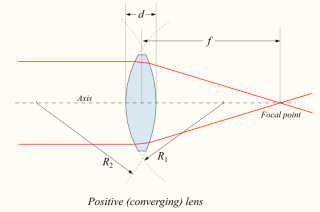
Concave lens
For a concave lens (negative or diverging), the rays, after passing through the lens, appear to emanate from a particular point on the lens axis in front of the lens. The distance from this point to the lens is known as the focal length, though it is negative with respect to the focal length of a converging lens. The following image illustrates this.
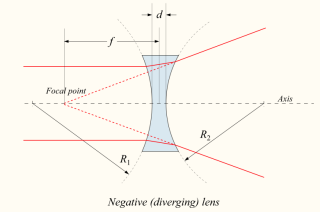
Plano-convex and plano-concave lenses have definitions of focal point and focal length similar to convex (biconvex) and concave (biconcave) as above, respectively.
Convex Mirror
For a convex mirror (diverging), focal point is the virtual point (inside the mirror) where the image is formed. Focal length is defined as the distance between the reflective surface of the mirror and the focal point, along the principal axis (as depicted in the image below).

Center of curvature, as seen above and as the name suggests, is the center of the virtual sphere from which the mirror is carved. Interestingly, focal length is half the distance of this center from the sphere surface along the principal axis (also the radius of the virtual sphere).
Concave Mirror
Focal point of a concave mirror (converging) is defined as the “real” point in front of the mirror where the image is formed. Focal length is the distance of this point from the reflective surface along the principal axis. As in a convex mirror, center of curvature can be similarly defined as the center of the virtual sphere from which the mirror is carved. The relation between the focal length and the radius of the sphere also holds the same.
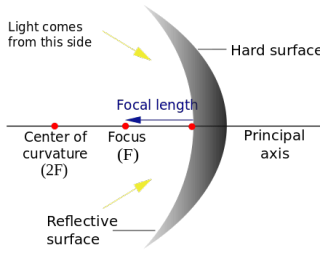
Now, let’s see what the aberrations, as you might have come across above, mean. These are important to learn and will make more sense as you study telescopes.
Aberration
What is an aberration?
An aberration is an anomaly, something that deviates from the normal way. Aberration leads to blurring of the image produced by an image-forming optical system. Makers of optical instruments need to correct optical systems to compensate for aberration.
Types of aberrations
Spherical aberration – Spherical aberration is an optical effect observed in an optical element (lens, mirror, etc.) that occurs due to the increased refraction of light rays when they strike a lens or a reflection of light rays when they strike a mirror near its edge, in comparison with those that strike nearer the center.[12]
Optical aberration – Optical aberration is a departure of the performance of an optical system from the predictions of paraxial optics (now, what in this world, does that mean?) Don’t worry too much about it! It occurs due to the not-so accurate approximations made in the theory that deals with tracing of light and not due to flaws in optical systems. It’s just that you can’t do much about it apart from choosing a good equipment that has this already compensated for and dealt by the manufacturer.[13]
Optical aberration can be chromatic or monochromatic in nature.
Chromatic aberration – We know regular, visible light is composed of different colors. This type of optical aberration is an effect resulting from dispersion (let’s just say, the change in the angle of refraction of different colors of light) in which there is a failure of a lens to focus all colors to the same convergence point. It occurs because lenses have different refractive indices for different wavelengths of light.[14]
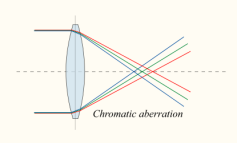
Now, as promised before, let’s see what an achromatic lens is.
An achromatic lens or achromat is a lens that is designed to limit the effects of chromatic and spherical aberration (discussed later). Achromatic lenses bring two wavelengths (typically red and blue) into focus in the same plane. An achromatic lens (usually an achromatic doublet) is a compound lens made with two types of glass with different dispersion. One element, a concave lens made out of Flint (metal oxides) glass, has relatively high dispersion (change in the angle of refraction of different colors of light), while the other, a convex element made of Crown glass (alkali-lime (RCH) silicates), has a lower dispersion. The crown lens is usually placed at the front due to the higher susceptibility of flint glass to atmospheric attack. The lens elements are mounted next to each other and shaped so that the chromatic aberration of one is counterbalanced by the chromatic aberration of the other, while the positive power of the crown lens element is not quite equaled by the negative power of the flint lens element. Together they form a weak positive lens that will bring two different wavelengths of light to a common focus.[15]

Monochromatic aberration – In simple terms, this refers to the optical distortion to monochromatic light (light of single color).[16] Monochromatic aberration can further be classified as one of five types, namely Spherical (discussed above), Comatic (coma), Astigmatism, Curvature of field and Distortion, although these aberrations are not limited to just the monochromatic realm.
Let’s describe each one briefly.
Spherical – As described above.
Coma – This type of aberration is inherent to certain optical designs or due to imperfection in the lens or other components that results in off-axis point sources such as stars appearing distorted, appearing to have a tail (coma) like a comet. This sort of aberration can also occur on chromatic light. Also, this aberration is very common in telescopes.[17]
Astigmatism – This type of aberration (like in the similarly named eye disorder) occurs when the rays that propagate in two perpendicular planes have different foci. If an optical system with astigmatism is used to form an image of a cross, the vertical and horizontal lines will be in sharp focus at two different distances.[18]
Curvature of field – Simplifying the complex (and more accurate) definition, in this aberration, an object cannot be brought properly into focus on a flat image plane.[19]
Distortion – This is a deviation from rectilinear projection (a projection in which straight lines in a scene remain straight in an image).[20]
Now, as we tread closer to learning about the design of telescopes, let’s learn about two primary optical constituents that form the soul of the telescope, objective and eyepiece. We will talk about the rest of the constituents in the sequel to this post as they vary according to the type of telescope.
Objective
Objective is the optical element that gathers light from the object being observed and focuses the light rays to produce a real image (you see why a convex mirror cannot be used as an objective – it does not produce a real image, as we learned before). Objectives can be a single lens or mirror, or combinations of several optical elements.[21] What antenna is to the radio, objective is to the telescope!
Eyepiece
Eyepiece, or ocular lens, is a type of lens that is attached to a variety of optical devices such as telescopes and microscopes. It is so named because it is usually the lens that is closest to the eye when someone looks through the device. The objective lens or mirror collects light and brings it to focus creating an image. The eyepiece is placed near the focal point of the objective to magnify this image. The amount of magnification depends on the focal length of the eyepiece.[22] What speaker is to the radio, eyepiece is to the telescope!
An eyepiece consists of several lenses in a housing, with a barrel on one end. The barrel is shaped to fit in a special opening of the instrument to which it is attached. The image can be focused by moving the eyepiece nearer and further from the objective. Most instruments have a focusing mechanism to allow movement of the shaft in which the eyepiece is mounted, without needing to manipulate the eyepiece directly.
The next post, Rudiments of telescopes, talks about the telescope, types of telescopes and their designs. Check it out!



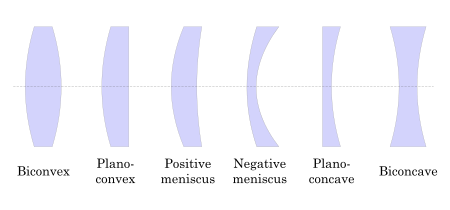
Tons of info here- Awesome. I’m reading it throughout my workday. Thanks so much!!
LikeLike